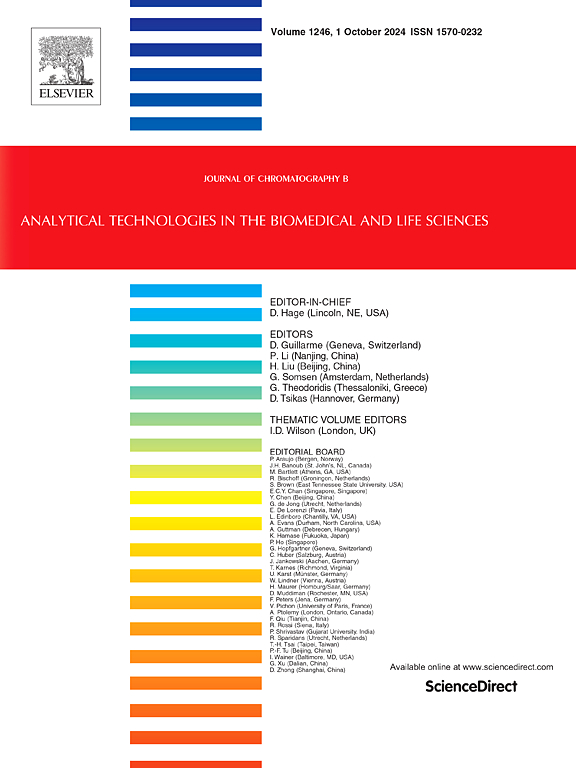Investigating the mechanism of action of Qianlie Jindan tablets in rats with chronic prostatitis using non-targeted metabolomics
IF 2.8
3区 医学
Q2 BIOCHEMICAL RESEARCH METHODS
引用次数: 0
Abstract
Objective
To explore the mechanism of action of Qianlie Jindan tablets by analyzing the metabolomic changes in prostate tissues obtained from rats with chronic prostatitis/chronic pelvic pain (CP/CPPS).
Materials and methods
Male SD rats were randomly divided into three groups: blank control (BC), model control (MC), and treatment (QLJD) groups, with 10 rats in each group. The model was induced using Complete Freund's adjuvant (CFA) and prostate protein purification solution, and the corresponding drug intervention was given. At the end of the experiment, pathological changes in the prostate tissues were observed using hematoxylin and eosin (HE) staining. Differential metabolites were determined by ultra-high-performance liquid chromatography and tandem electrostatic field orbital trap mass spectrometry (UHPLC-Q Exactive HFX), and Kyoto Encyclopedia of Genes and Genomes (KEGG) pathway annotation was performed. The results were then verified by quantitative real-time polymerase chain reaction (PCR).
Results
QLJD reversed the histopathological damage induced by CP/CPPS. Metabolomics analysis showed that UDP-GlcNAc was the key differential metabolite, and can activate the PI3K/AKT/mTOR pathway. The PCR analysis revealed that the mRNA expression levels of PI3K, AKT and mTOR in the MC group were significantly lower than those in the BC group (P < 0.05). These parameters were increased in the QLJD group compared to the MC group (P < 0.05), validating our metabolomics results.
Conclusion
QLJD exerts a therapeutic effect on CP/CPPS by activating the PI3K/AKT/mTOR pathway through the regulation of UDP-GlcNAc levels.
用非靶向代谢组学方法研究千烈金丹片对慢性前列腺炎大鼠的作用机制
目的通过分析慢性前列腺炎/慢性盆腔痛(CP/CPPS)大鼠前列腺组织代谢组学变化,探讨前列金丹片的作用机制。材料与方法将SD大鼠随机分为空白对照组(BC)、模型对照组(MC)和治疗组(QLJD),每组10只。采用完全弗氏佐剂(CFA)和前列腺蛋白纯化液诱导模型,并给予相应的药物干预。实验结束时,采用苏木精和伊红(HE)染色观察前列腺组织的病理变化。采用超高效液相色谱和串联静电场轨道阱质谱(UHPLC-Q Exactive HFX)测定差异代谢物,并进行京都基因与基因组百科全书(KEGG)通路注释。然后用实时定量聚合酶链反应(PCR)验证结果。结果qljd可逆转CP/CPPS诱导的组织病理损伤。代谢组学分析显示,UDP-GlcNAc是关键的差异代谢物,可以激活PI3K/AKT/mTOR通路。PCR分析显示,MC组PI3K、AKT和mTOR mRNA表达水平显著低于BC组(P <;0.05)。与MC组相比,QLJD组的这些参数均有所增加(P <;0.05),验证了我们的代谢组学结果。结论qljd通过调节UDP-GlcNAc水平,激活PI3K/AKT/mTOR通路,对CP/CPPS有治疗作用。
本文章由计算机程序翻译,如有差异,请以英文原文为准。
求助全文
约1分钟内获得全文
求助全文
来源期刊

Journal of Chromatography B
医学-分析化学
CiteScore
5.60
自引率
3.30%
发文量
306
审稿时长
44 days
期刊介绍:
The Journal of Chromatography B publishes papers on developments in separation science relevant to biology and biomedical research including both fundamental advances and applications. Analytical techniques which may be considered include the various facets of chromatography, electrophoresis and related methods, affinity and immunoaffinity-based methodologies, hyphenated and other multi-dimensional techniques, and microanalytical approaches. The journal also considers articles reporting developments in sample preparation, detection techniques including mass spectrometry, and data handling and analysis.
Developments related to preparative separations for the isolation and purification of components of biological systems may be published, including chromatographic and electrophoretic methods, affinity separations, field flow fractionation and other preparative approaches.
Applications to the analysis of biological systems and samples will be considered when the analytical science contains a significant element of novelty, e.g. a new approach to the separation of a compound, novel combination of analytical techniques, or significantly improved analytical performance.
 求助内容:
求助内容: 应助结果提醒方式:
应助结果提醒方式:


